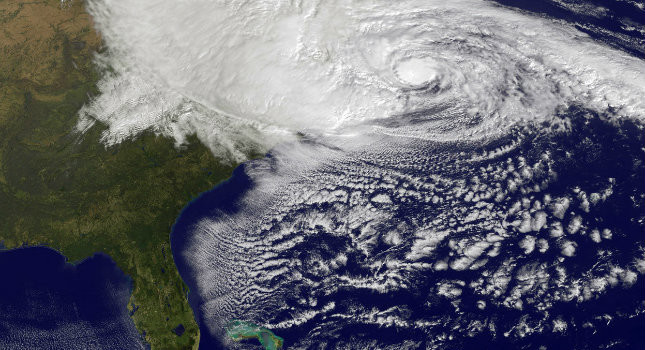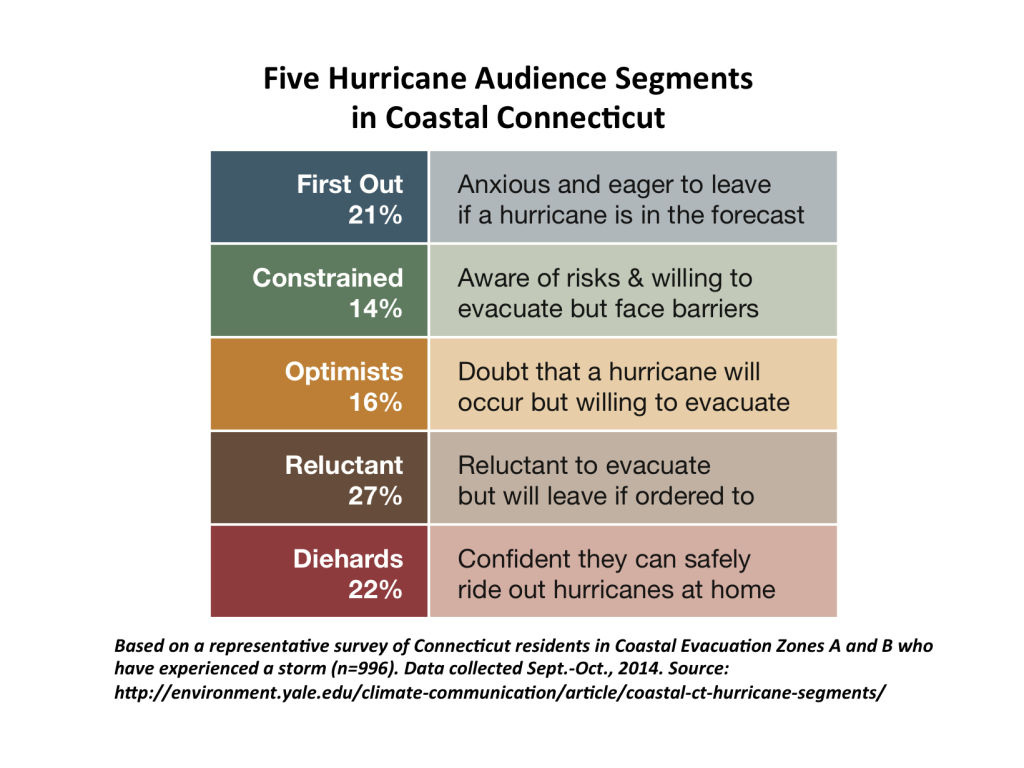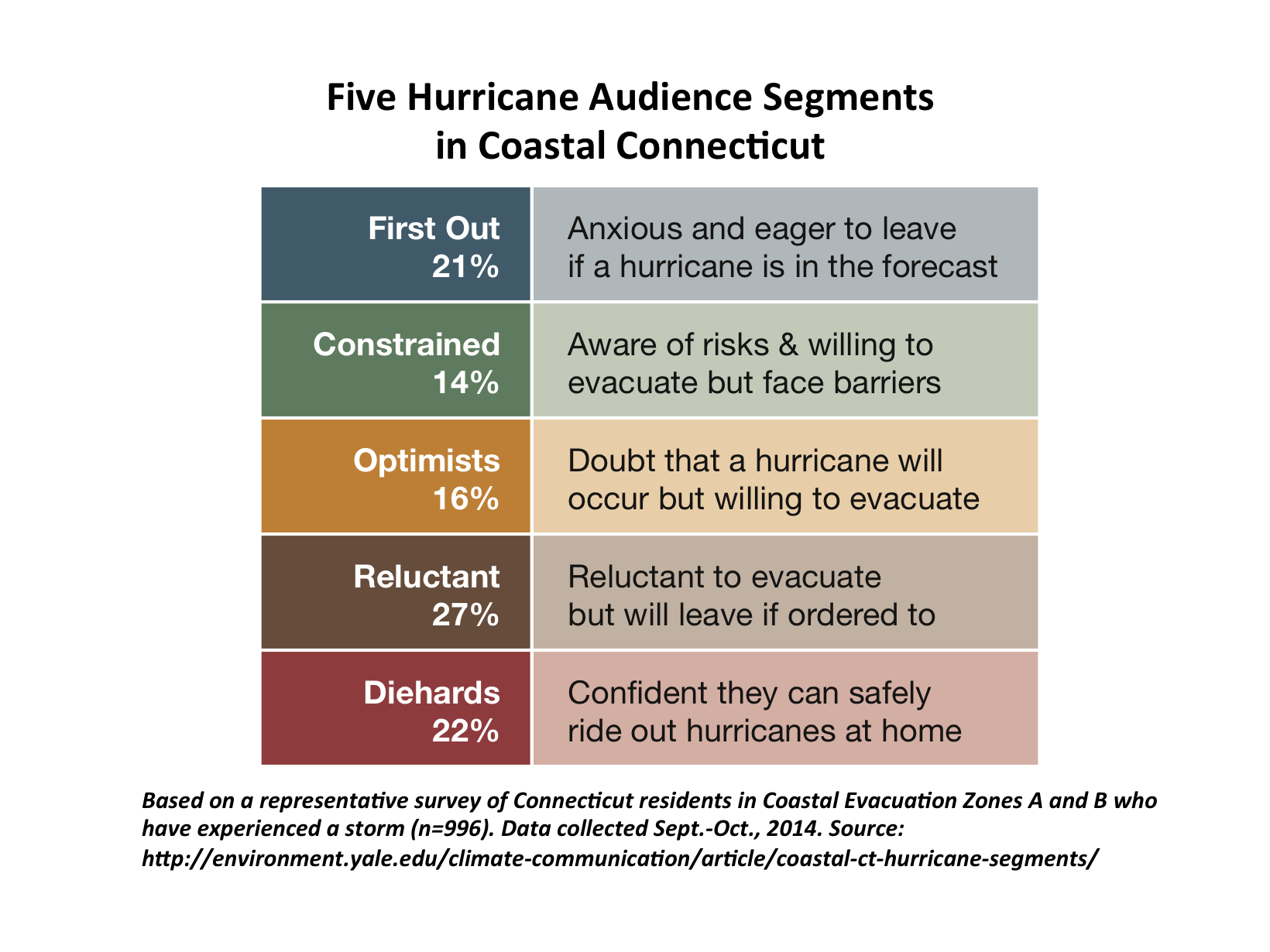Report · Jun 29, 2015
Hurricane Attitudes of Coastal Connecticut Residents: A Segmentation Analysis to Support Communication
By Jennifer Marlon, Anthony Leiserowitz, Geoff Feinberg and Seth Rosenthal
Filed under: Audiences, Climate Impacts and Beliefs & Attitudes

Report Summary
As Superstorm Sandy battered the U.S. East Coast in 2012, residents in communities along the Connecticut shore received “mandatory” evacuation orders, but most people didn’t leave. Our new study, “Hurricane Attitudes of Coastal Connecticut Residents: A Segmentation Analysis,” provides insights into why some people decide to evacuate in the face of a weather emergency and why others try to ride out the storm.
The report identifies five distinct groups of CT coastal residents based on their attitudes towards hurricanes: the “First Out” (21% of the population); the “Constrained” (14%); the “Optimists” (16%); the “Reluctant” (27%); and the “Diehards (22%).” The First Out are the most likely to evacuate during a hurricane whereas the Diehards are the least likely to leave. Each group, however, has unique characteristics.
- The First Out perceive the greatest risk from hurricanes and are likely to evacuate if one is forecast to make landfall nearby. Of the First Out residents who experienced Superstorm Sandy, 55% evacuated.
- The Constrained understand the risks of staying home during a hurricane, but feel they would have trouble evacuating if they wanted (or needed) to due to poor health/disability, pets, or lack of money. 22% of the Constrained evacuated during Superstorm Sandy – the highest proportion other than the First Out segment.
- Optimists have the lowest expectations of all the groups that a hurricane of any strength will occur in the next 50 years, although they say they would evacuate if one did occur. Perhaps because they think hurricanes are so unlikely, Optimists are the least prepared and most likely of all the groups to perceive significant barriers to evacuating, such as health/disability issues, lack of money, and lack of know-how.
- The Reluctant are less afraid of hurricanes than average and tend to live farther from the coast than the other groups. However, Reluctant individuals would evacuate if told to do so by a relevant authority – especially local police or fire departments, another local government official, or the Governor’s Office. Like the First Out, the Reluctant do not perceive significant barriers to their evacuation, and with an evacuation order, they are likely to evacuate at levels similar to the First Out.
- Diehards have the lowest hurricane risk perceptions of all the groups and are the least likely to evacuate. Diehards feel self-reliant and confident that they can protect themselves; they also believe it is safer to stay home than to evacuate so they can protect their property. Pets are an important barrier to leaving for 25% of the Diehards. Of the Diehards who experienced Superstorm Sandy, only 6% evacuated.
- All of the segments are most likely to evacuate if they receive an evacuation order from local officials, whether police, fire, or other government workers (as compared with announcements from weather broadcasters or other sources on the TV or radio).
The unique perceptions and needs of coastal Connecticut residents in the event of a hurricane underscores the importance of tailoring messages about storm preparedness, the nature of storm hazards and the likelihood of different damages, as well as evacuation resources. Some groups understand the risks and need minimal information in order to respond appropriately, whereas others understand the risks but need assistance. Still others misunderstand the risks and thus require education and outreach efforts well before a hurricane makes landfall. A better understanding of hurricane attitudes is needed to improve communication efforts in the emergency management community.
Key Statistics
One reason that a "First Out" gave for leaving:
"I do not want people to endanger themselves in a possible rescue attempt."
A quote from an anonymous "Optimist" after Sandy:
"Next time I may think of leaving cause it was pretty bad!"
Why did one "Diehard" stay home during Sandy?
[Because I was] "prepared with generator and precooked food."
This study of hurricane attitudes is based on data from a representative survey of 1,130 households along the Connecticut coast described in our first report, Hurricane Perceptions of Coastal Connecticut Residents released March 20, 2015. Funding for this project came from the Coastal Storm Awareness Program (NOAA awards NA13OAR4830227, NA13OAR4830228, NA13OAR4830229) at the National Sea Grant College Program, National Oceanic and Atmospheric Administration, U.S. Department of Commerce, with additional support from the Energy Foundation.

